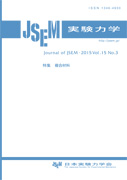Volume 15, Issue 3
Displaying 1-12 of 12 articles from this issue
- |<
- <
- 1
- >
- >|
Original Papers
-
2015Volume 15Issue 3 Pages 169-174
Published: September 29, 2015
Released on J-STAGE: October 01, 2015
Download PDF (1185K) -
2015Volume 15Issue 3 Pages 175-180
Published: September 29, 2015
Released on J-STAGE: October 01, 2015
Download PDF (1121K) -
2015Volume 15Issue 3 Pages 181-187
Published: September 29, 2015
Released on J-STAGE: October 01, 2015
Download PDF (1186K) -
2015Volume 15Issue 3 Pages 188-193
Published: September 29, 2015
Released on J-STAGE: October 01, 2015
Download PDF (1184K) -
2015Volume 15Issue 3 Pages 194-199
Published: September 29, 2015
Released on J-STAGE: October 01, 2015
Download PDF (1749K) -
2015Volume 15Issue 3 Pages 200-204
Published: September 29, 2015
Released on J-STAGE: October 01, 2015
Download PDF (1002K)
Original Papers
-
2015Volume 15Issue 3 Pages 205-209
Published: September 29, 2015
Released on J-STAGE: October 01, 2015
Download PDF (1072K) -
2015Volume 15Issue 3 Pages 210-216
Published: September 29, 2015
Released on J-STAGE: October 01, 2015
Download PDF (1418K) -
2015Volume 15Issue 3 Pages 217-224
Published: September 29, 2015
Released on J-STAGE: October 01, 2015
Download PDF (522K) -
2015Volume 15Issue 3 Pages 225-230
Published: September 29, 2015
Released on J-STAGE: October 01, 2015
Download PDF (938K) -
2015Volume 15Issue 3 Pages 231-238
Published: September 29, 2015
Released on J-STAGE: October 01, 2015
Download PDF (1356K)
Erratum
-
2015Volume 15Issue 3 Pages E1-E2
Published: September 29, 2015
Released on J-STAGE: October 01, 2015
Download PDF (2315K)
- |<
- <
- 1
- >
- >|
